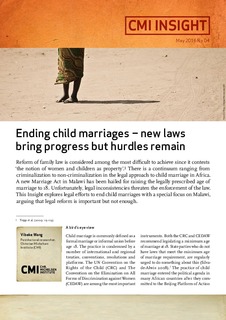Ending child marriages – new laws bring progress but hurdles remain
Report
Permanent lenke
http://hdl.handle.net/11250/2475409Utgivelsesdato
2016-05-01Metadata
Vis full innførselSamlinger
- Publications [1488]
Originalversjon
Bergen: Chr. Michelsen Institute (CMI Insight no. 4) 8 p.Sammendrag
Reform of family law is considered among the most difficult to achieve since it contests ‘the notion of women and children as property’. There is a continuum ranging from criminalization to non-criminalization in the legal approach to child marriage in Africa. A new Marriage Act in Malawi has been hailed for raising the legally prescribed age of marriage to 18. Unfortunately, legal inconsistencies threaten the enforcement of the law. This Insight explores legal efforts to end child marriages with a special focus on Malawi, arguing that legal reform is important but not enough.
A bird’s eye view Child marriage is commonly defined as a formal marriage or informal union before age 18. The practice is condemned by a number of international and regional treaties, conventions, resolutions and platforms. The UN Convention on the Rights of the Child (CRC) and The Convention on the Elimination on All Forms of Discrimination against Women (CEDAW) are among the most important instruments. Both the CRC and CEDAW recommend legislating a minimum age of marriage at 18. State parties who do not have laws that meet the minimum age of marriage requirement, are regularly urged to do something about this (Silva-de-Alwis 2008). The practice of child marriage entered the political agenda in many African countries after they committed to the Beijing Platform of Action in 1995. The platform calls upon states to enforce laws securing a minimum age for (Bejing Platform for Action, Chapter IV, 274e). International and regional human rights condemn child marriage as a human rights violation detrimental to girls and women’s rights to health, education and to live free from violence. II There is a growing literature on the harmful consequences of child marriage (see e.g. Singh and Samara 1996; Raj et al. 2009; Parsons et al. 2015), but less knowledge about the process leading up to child marriage law reform (for notable exceptions see
